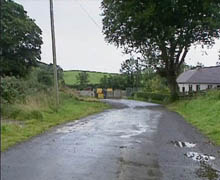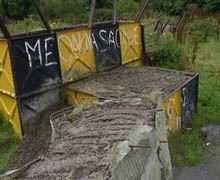Social and economic effects
The borderlands of Northern Ireland and Ireland are amongst the most disadvantaged and deprived areas of the island. Though places near the border's eastern region, including the cities of Newry in Northern Ireland and Dundalk in Ireland, have recently grown in prosperity as part of the Belfast-Dublin axis of development, most of the borderlands were badly affected by the Troubles and continue to suffer the significant negative economic and social effects the border.
As in other contexts, the creation of a border in an area previously traversed by long-standing and multiple networks – familial, social, economic – dramatically distorted or destroyed these existing links and interconnections. While some pre-partition social networks continued on a cross-border regional or all-island basis, for many people old patterns of family connections and friendships were broken, severely curtailed, or a struggle to maintain. Restrictions on movement across the border had the most obvious effect, but patterns of sociability were also affected by the tensions surrounding the border itself. Former cross-community contacts were affected by local incidents and the wider political climate. See Living with the Border.
And as is the case with other border areas, those living near the Irish border have experienced the isolation and marginalisation that often comes from being at the edges of their country's territorial frontiers and far from its centres of power and prosperity. The effects of the border are especially difficult for more socially disadvantaged groups; the border compounds the difficulties facing many women, young people looking for work in areas with few jobs and opportunities, old people living in isolated rural areas with poor services and poor public transport. One recent study has also highlighted the difficulties of those who moved to the border counties of Ireland as former republican prisoners or those displaced because of violence in the early years of the Troubles, who face specific problems of lack of employment and local acceptance. Protestant people in the border counties vary in their sense of identity and integration but for some the common problems of the border regions are compounded by senses of isolation or their lack of acceptance as Protestants in largely Catholic areas.
Even before the decades of violence, the creation of the border badly affected existing retailers, manufacturers and services near the border. For many business the cost and inconvenience of new customs system – duties, paper work, delays and longer journeys – as well as the growing divergence in the administrative systems on either side created difficulties which led to a dramatic decline in trade across the border. Many retailers were cut off from their established market areas and failed to survive.

Road closure at Lackey Bridge. Source: UTV news footage, 4 September 1994.
In turn, the difficulties of dealing with the border, which after 1979 included dealing with the currency difference between Ireland and the United Kingdom, as well as different legal and taxation systems, discouraged inward investment. Existing business struggled to survive and few new industries were established. The difficulties of making a living from agriculture in these largely rural regions of Ireland and Northern Ireland were made even harder as farmers had to cope with being separated from their nearest fairs and traders, or in many cases having their own holdings truncated by the border. The lack of recognition of professional qualifications gained on either side of the border as well as divergent legal systems similarly curtailed older patterns of service provision and employment.
The viability of the pre-partition rail network and the prospects for alternative public bus services in the borderlands were badly affected by the border which truncated the old rail network and created difficulties in providing cross-border bus transport. The border also cut through the former regional organisation of postal collection and delivery, education and health care and increased the costs of the provision of these services. It is argued that these increased costs have not been dealt with through increased state support, with the result that the Irish borderlands have suffered from decades of underinvestment. People living very close to each other but across the border have also been affected by the distinctive government policy on either side; with the benefits of the British welfare state from the 1950s contrasting with less generous welfare provision in Ireland, for example. These cross border contrasts of policy or prosperity often characterise border regions.
In the Irish case, the effects of the border have also been deeply shaped by patterns of religious, ethnic and political division that led to partition and the conflict over the existence of border itself. The borderlands were places of conflict and tension following partition and during the IRA Border Campaign 1956-62. Though there were calmer periods before the Troubles, some of the worst violence of these three decades that happened outside Belfast took place in the borderlands. From the early 1970s the already considerable inconveniences of the border were compounded by the effects of the new security measures - armed checkpoint searches, surveillance and road blocks. For many, borderland life was dominated by fear, insecurity and intimidation. This instability made the region even less attractive to those looking for places for establish industries or businesses.

Concrete blocks at Lackey Bridge. Source: UTV news footage, 4 September 1994.
The case of Clones in north Co. Monaghan is a particularly vivid example of wider patterns of disruption and economic decline produced by the border. Less than 1 km from the border, the natural economic hinterland of this formerly thriving market and railway town was once east Fermanagh. Over the course of the twentieth century the town has experienced massive decline. Following partition shops and businesses were cut off from their customers across the border, first by the customs barrier and later in the 1970s and 1980s by the physical closure of the roads out of the town that used to cross the county boundary. The destruction of Lackey Bridge on the road northwards out of the town to the border with Co. Fermanagh is especially notorious as it severed the historical connections between the town and its surrounding rural community to the north. The effects of the border were made worst by the closure in 1958 of the railway lines that were so much part of the town's former prosperity as the hub of the railway network in Ulster and were so vital to the prosperity of the border counties and other border towns like Strabane. Being so near a heavily militarized border with its check points and searches, and being the target of bombs in the early 1970s, Clones suffered too from the effects of decades of conflict in the borderlands: economic decline, deprivation, depopulation, underinvestment, neglect and the decline of social and community life.
